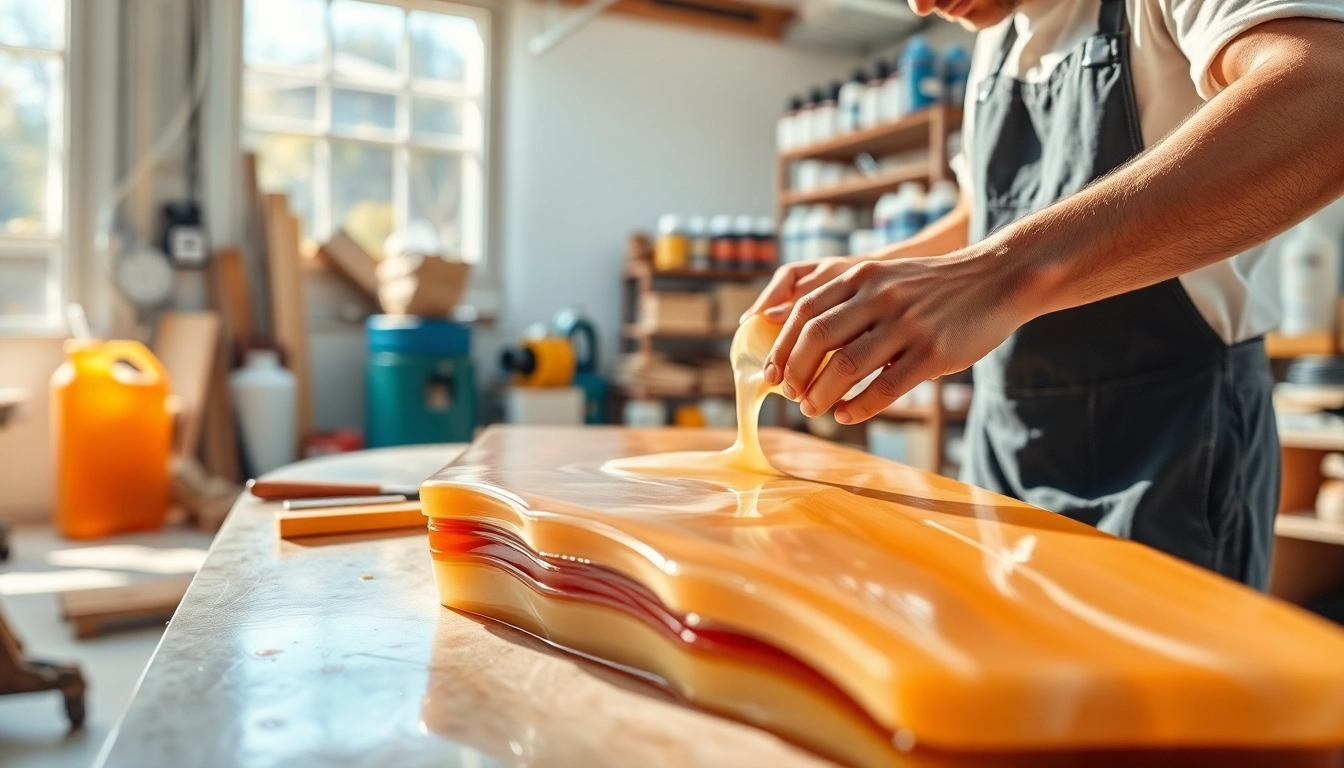
Introduction to Laminating Resin
Laminating resins are pivotal in several industries ranging from marine construction to automotive manufacturing and aerospace engineering. These resins play a critical role in reinforcing materials, forming a durable composite that offers strength and longevity. Understanding this material’s nature, applications, and benefits is essential for professionals dealing with composite structures. This article delves into the intricacies of laminating resin, exploring its definition, composition, applications, and how it revolutionizes various industries.
Definition and Composition of Laminating Resin
Laminating resin is a thermosetting resin used primarily for creating composite materials. It is designed to bond layers of material, such as fiberglass, carbon fiber, or other fillers, together to create a sturdy laminate. Its composition usually involves a base resin (often epoxy or polyester) mixed with a curing agent or hardener. The chemical reaction caused by this mix results in a solid material, which enhances the mechanical properties of the composite.
The two most common types of laminating resins are:
- Polyester Laminating Resin: This type is popular due to its cost-effectiveness and ease of use. Polyester resins cure quickly and can be modified for specific applications, making them a favorite in boat building and automotive repairs.
- Epoxy Laminating Resin: Epoxy resins are preferred for applications requiring superior strength, chemical resistance, and bonding capabilities. They have a longer curing time but provide enhanced durability and thermal resistance.
Applications in Various Industries
The versatility of laminating resin allows for its application across diverse sectors. Here are some key industries where laminating resin plays a crucial role:
- Marine Industry: Used in constructing hulls and structures of boats, laminating resin provides the necessary waterproofing and strength needed for marine applications.
- Aerospace: Laminating resins are vital in the fabrication of lightweight and robust components in aircraft, contributing to fuel efficiency and performance.
- Automotive: In car manufacturing, laminating resins enhance the performance of body panels and internal structures, combining strength with reduced weight.
- Construction: Laminate flooring, panels, and other building materials often utilize laminating resin to improve structural integrity and aesthetics.
Benefits of Using Laminating Resin
The benefits of using laminating resin are numerous and significant, making it a preferred choice for many applications:
- Strength and Durability: Laminating resins impart exceptional strength, enabling structures to resist stress and impact.
- Versatility: The adaptability of laminating resins allows them to be tailored for various applications, enhancing their utility across sectors.
- Corrosion Resistance: When cured, laminating resins exhibit excellent resistance to moisture and chemicals, extending the lifespan of products manufactured with them.
- Cost-Effectiveness: Particularly polyester laminating resin provides a budget-friendly solution while meeting the performance requirements of many industrial applications.
Choosing the Right Laminating Resin
Types of Laminating Resin Available
- Vinyl Ester Resins: Offering superior chemical resistance and mechanical properties, vinyl ester resins are often used in applications requiring high corrosion resistance.
- Hybrid Resins: Combining different resin types can lead to customized solutions for specific project requirements, balancing cost, strength, and curing time.
Key Factors to Consider When Selecting Laminating Resin
Several factors should guide the selection of the right laminating resin for a given application:
- Application Environment: Consider the environmental factors such as humidity, temperature, and exposure to chemicals that the laminated structure will face.
- Curing Time: Depending on production schedules and requirements, the curing time of different resins can significantly impact project timelines.
- Mechanical and Thermal Properties: Assess the strength and weight requirements of the laminate, ensuring the selected resin meets structural demands.
- Cost and Availability: Budget considerations and the availability of the materials should also factor into your decision.
Common Mistakes to Avoid in Selection
Inappropriately selecting laminating resin can lead to project failures. Here are common pitfalls:
- Ignoring Compatibility: Using dissimilar materials without proper testing can lead to adhesion failures.
- Underestimating End Use: Failing to account for environmental stressors may result in materials that do not perform as expected.
- Disregarding Manufacturer Guidelines: It is crucial to follow the resin manufacturer’s recommendations for optimal results.
Techniques for Working with Laminating Resin
Surface Preparation for Optimal Adhesion
Proper surface preparation is essential to achieve optimal adhesion with laminating resin. Consider the following steps:
- Cleaning: Remove any contaminants, dust, oils, or grease from the surface.
- Mechanical Abrasion: Sanding the surface can improve mechanical bonding. Use appropriate grits to create a profile without damaging the substrate.
- Drying: Ensure the surface is completely dry before applying resin, as moisture can impede the curing process.
Mixing and Application Guidelines
Mixing requires precision to achieve desired properties:
- Ratio: Follow exact mixing ratios specified by the manufacturer, as any deviation can affect the resin’s performance.
- Temperature: Both mixed resin and ambient temperatures can impact curing times and mechanical properties. Ensure temperatures are within the suggested limits.
- Application Tools: Utilize appropriate tools (brushes, rollers, etc.) for even application across the surface.
Curing Process and Timeframes
The curing process is a critical stage in using laminating resin. Here are important factors:
- Timeframes: Depending on the resin type and ambient conditions, curing times can range from minutes to weeks.
- Post-Curing: Following initial curing, additional heat or pressure may be applied to enhance the material’s properties.
- Humidity and Temperature Effects: High humidity levels can prolong curing times, while low temperatures may necessitate preheating.
Best Practices for Laminating Resin Projects
Safety Protocols When Handling Laminating Resin
Working with laminating resin necessitates strict adherence to safety protocols:
- Personal Protective Equipment (PPE): Always wear gloves, goggles, and respirators to protect against exposure to chemicals.
- Ventilation: Ensure worksites are well-ventilated to minimize fumes and create a safe working environment.
- Emergency Procedures: Familiarize yourself with safety data sheets (SDS) and emergency procedures for handling spills or exposure events.
Maintaining Quality in Fabrication
Quality assurance during fabrication can be achieved by implementing various strategies:
- Quality Control Checks: Regularly inspect materials, mixing processes, and final products for consistency.
- Training: Ensure personnel are adequately trained in best practices for working with laminating resin.
- Documentation: Maintain records of materials used, processes employed, and any deviations from the standard protocol.
Post-Application Care and Maintenance
After application, the longevity and integrity of laminated products rely on proper care:
- Storage Conditions: Keep laminated items in conditions that avoid excessive heat and moisture.
- Periodic Inspections: Conduct routine checks for wear, cracks, or damage and address issues immediately.
Advanced Applications and Innovations in Laminating Resin
Emerging Trends in Laminating Resin Technology
Technological advancements are continually shaping the future of laminating resin applications:
- Smart Resins: Incorporating sensors within laminating resins to monitor health status and environmental conditions.
- Biodegradable Resins: Research into environmentally friendly alternatives that can reduce impact on ecosystems while maintaining performance standards.
- 3D Printing: Integration of laminating resins in additive manufacturing processes to create complex structures using lightweight materials.
Case Studies of Successful Laminating Resin Applications
Examples of successful applications can provide valuable insights. In various industries, laminated composites have led to breakthroughs:
- Marine Construction: Projects showcasing enhanced durability in vessel performance through the use of adapted laminating resins.
- Aerospace Innovations: Utilizing lighter materials with laminating resins to enhance fuel efficiency while ensuring structural integrity.
Future Outlook for Laminating Resin in Manufacturing
The future of laminating resin holds promising developments, driven by innovation and sustainability. Prominent trends expected to shape its trajectory include:
- Increased Demand for Lightweight Materials: As industries strive for improved energy efficiency, laminating resins will play a critical role in producing lightweight solutions.
- Cost Reduction Strategies: Continued research will lead to more economical manufacturing processes, making high-performance laminating resin accessible to even more applications.
- Sustainability Goals: The push towards sustainable practices will drive the development of renewable source materials and production processes in laminating resin technology.





